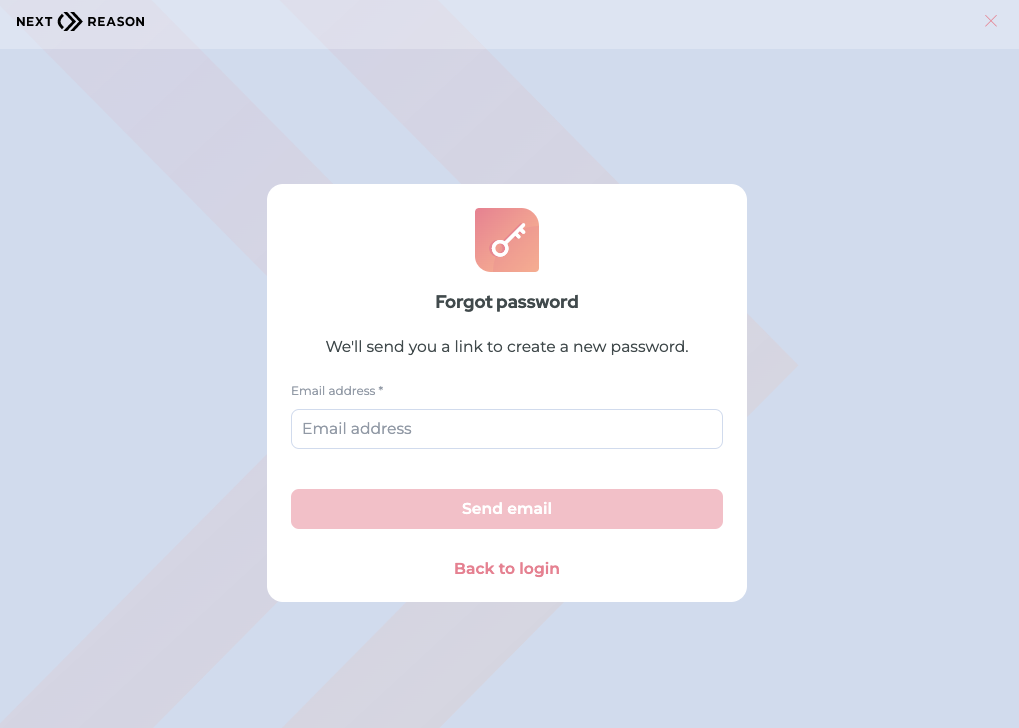How to integrate the Next Identity Hosted Journeys forgot password workflow
You can initiate a forgot password journey either when a user clicks on that user journey link in the /authorize screen, or you can take a user directly to that form by passing in a URL.
Integrating the forgot password screen via a URL requires further configuration.

Endpoint URL
The forgot password request consists of the base domain + the endpoint (/forgot-password) + parameters. Available parameters are listed below the example.
https://id.eu.nextreason.com/
forgot-password?
redirect_uri={{redirect_uri}}
&client_id={{client_id}}
&response_type=code
&state={{state}}
&scope=openid
&nonce={{nonce_value}}
&ui_locales=en-US
&code_challenge={{code_challange}}
&code_challenge_method=S256Required Parameters
The following parameters must be included on every request.
Parameter | Description |
|---|---|
| Configures the URL the user is redirected after a successful authentication.
|
| ID used to authenticate the API call. This client must be configured with the |
| Value that determines the authorization processing flow to be used, including what parameters are returned from the endpoints. We only support authorization code flow which means the only acceptable parameter is: |
| This Typically for applications, Cross-Site Request Forgery (CSRF, XSRF) mitigation is done by cryptographically binding the value of this parameter with a browser cookie. This value is required on every call, but the hosted service does not use this value in any way, it is solely for use by the application. Doing so, the application can check and evaluate the value of the state parameter if it is correct or meets a specified criteria then perform expected actions or user journeys on the application-side. |
| OpenID Connect requests must contain the |
Optional Parameters
The following parameters are optional.
Parameter | Description |
|---|---|
| Space delimited, case sensitive list of ASCII string values that specifies whether the Authorization Server prompts the End-User for reauthentication and consent. The defined values are:
|
| Set the language to be displayed in the screen. Session cookie will save the locale setting sent for the first time, if this parameter is not present the latest language saved will be used to display the screen. It allows multiple locales and in case there's no configuration for the first one, it searches for the second one and so on. Since the See Localization for list of supported locales and the accepted values. The default country flag during mobile login or when changing the mobile number will be determined by the ui_locales in the query string parameters, if the mobile_query_default_flag is set in the configuration settings. If not, it will fall back to the mobile_default_country, then to the first value in the mobile_flag_countries setting, and finally to the default_locale. |
| String value used to associate a client session with an ID token and to mitigate replay attacks. The value is passed through unmodified from the Authentication Request to the ID Token. Sufficient entropy must be present in the nonce values used to prevent attackers from guessing values. |
| The ID of the environment where the client is created. Each environment (for example, DEV, UAT or PROD) has their own environment_id. |
| The ID of the organization in the Next Identity. Each Organization has their own organization_id. |
| Used in PKCE protocol. |
| Used in PKCE protocol. |
| If this parameter value is passed with the call to the /authorize or /register endpoints, the email address or mobile number field on the hosted screen will be pre-filled. This applies to both email addresses and mobile phone numbers. |
Response Handling
The forgot-password begins with your application directing users to the hosted /authorize endpoint. Then after clicking the forgot-password link, you will be prompted to enter the email address that you will reset the password.
After entering the email address, the user will receive a Reset Password email. The user will click the link in the email and will be redirected to the new window where they Create a New Password. User will then create a new password and click the Reset password button. After successfully resetting the password, the user will receive another email indicating that the password was updated successfully. The user can now use the new password created to login to the application.
Configuration Options
The attributes are customizable based on the requirements.
| Configuration Option | Description |
|---|---|
| Custom Branding | Client has the option to add a brand logo, header logo, background image, favicon, button color and font style in the Authorize Page. |
Error Handling
| Code | Error | Cause |
|---|---|---|
| No code, error message only | Email address is not formatted correctly | Email format is incorect |
| No code, error message only | Complete your account registration | The account was not verified yet |
| No code, error message only | There was a security error with the form submission | The authorize page is left idle for 2 minutes |
| No code, error message only | Corrupt image | The assets, such as the logo or image, are pointing to a location that does not exist |
Security Considerations
While the state parameter is not directly used within the register endpoint itself, it plays a critical role in ensuring the secure handling of the authorization process that leads to accessing the authorized page endpoint.
Integration
Forgot-password is already integrated in the authorize page. No other integration needed for Hosted Login Journeys.
